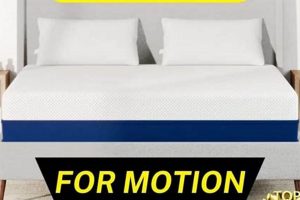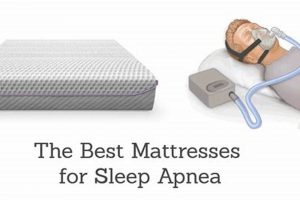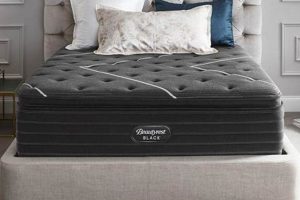The optimal support system for a hybrid sleep surface is designed to enhance its performance and longevity. These support structures ensure proper weight distribution, prevent sagging, and contribute to the overall comfort and feel of the mattress. A well-chosen base can significantly impact the lifespan and comfort provided by the hybrid mattress.
Selecting an appropriate base is crucial for preserving the integrity of a hybrid mattress. It promotes airflow, which is vital for temperature regulation and preventing moisture buildup. Historically, various materials have been used, from simple wooden frames to more sophisticated adjustable models, each offering distinct advantages and disadvantages in terms of support, durability, and aesthetic appeal.
This exploration delves into the key considerations when selecting the ideal base for a hybrid mattress. It will cover the different types available, their respective benefits and drawbacks, and factors such as material, construction, and compatibility to ensure optimal performance and lifespan.
Guidance for Selecting a Suitable Base
The selection of an appropriate base is paramount to maximizing the benefits and longevity of a hybrid mattress. Careful consideration of several factors can ensure optimal support and performance.
Tip 1: Assess Mattress Compatibility: Verify that the chosen base is compatible with the specific type of hybrid mattress being used. Some manufacturers provide guidelines regarding recommended support structures.
Tip 2: Evaluate Support Structure: Consider the weight-bearing capacity of the base. It must be able to adequately support the combined weight of the mattress and its occupants to prevent sagging and premature wear.
Tip 3: Examine Material Durability: Opt for a base constructed from durable materials, such as solid wood or reinforced steel. These materials offer greater stability and resistance to damage over time.
Tip 4: Prioritize Proper Ventilation: Choose a base that promotes airflow beneath the mattress. This helps to regulate temperature and prevent the accumulation of moisture, which can lead to mold or mildew.
Tip 5: Consider Height Preferences: Evaluate the desired bed height. A higher base may be more comfortable for individuals with mobility issues, while a lower profile may be preferred for aesthetic reasons.
Tip 6: Investigate Noise Reduction Features: If noise is a concern, select a base with features designed to minimize squeaking or creaking. Some models incorporate padding or reinforced joints to reduce noise transmission.
Tip 7: Explore Adjustable Options: For enhanced comfort and customization, consider an adjustable base. These bases allow users to adjust the head and foot sections of the mattress, which can be beneficial for individuals with certain medical conditions.
Selecting the correct support system results in enhanced comfort, increased mattress lifespan, and improved sleep quality. Careful consideration of these factors can ensure optimal performance and long-term value.
The next section will delve into specific types of support structures suitable for hybrid mattresses and their respective advantages.
1. Proper Support
Proper support is a foundational element in selecting the ideal base. The mattress relies on the base to evenly distribute weight, preventing concentrated pressure points that can lead to premature wear and tear. Without adequate support, the hybrid mattress’s core components, such as the innerspring system and comfort layers, may compress unevenly, compromising their intended function. The base effectively acts as the skeletal framework that upholds the structure. For example, a flimsy slatted foundation with wide gaps may cause the mattress to sag between the slats, negating the benefits of the mattress’s design and potentially voiding the manufacturer’s warranty.
The consequences of inadequate support extend beyond mattress longevity. Misalignment can lead to discomfort, disrupted sleep, and even exacerbate existing musculoskeletal issues. In contrast, a robust platform bed, offering a solid and level surface, provides consistent support across the entire mattress area. This ensures the innerspring system functions correctly, allowing it to adapt to the sleeper’s contours and provide targeted support where it is needed most. Furthermore, a base that does not adequately support the mattress can compromise airflow, contributing to temperature regulation issues during sleep.
In summary, proper support is not merely a desirable feature but an essential prerequisite for realizing the full potential of the hybrid mattress. It directly impacts the mattress’s lifespan, comfort, and overall performance. Selecting a base that provides a stable, level, and weight-appropriate foundation is paramount to optimizing the sleep experience and preserving the investment in the mattress itself. Understanding this connection is crucial for making informed purchasing decisions and avoiding potential issues associated with inadequate support.
2. Airflow Enhancement
Airflow enhancement is a critical consideration when selecting the optimal base for a hybrid mattress. Hybrid mattresses, by their nature, often incorporate layers of memory foam, which, while providing comfort, can restrict airflow and contribute to heat retention. An inadequate base can exacerbate this issue, creating a sleep environment prone to overheating. Conversely, a base designed to promote airflow mitigates this problem, facilitating the dissipation of heat and moisture, thereby enhancing sleep quality.
The impact of airflow enhancement extends beyond temperature regulation. Proper ventilation minimizes the risk of mold and mildew growth within the mattress, contributing to a more hygienic sleep surface. A base with slatted construction, for instance, allows air to circulate freely beneath the mattress, preventing moisture accumulation. Conversely, a solid platform base without ventilation holes can trap moisture, potentially leading to the degradation of mattress materials and the proliferation of allergens. Real-world examples demonstrate that individuals using hybrid mattresses on poorly ventilated bases often report experiencing night sweats and discomfort, while those using well-ventilated bases report improved temperature regulation and overall comfort. The practical significance of this understanding lies in the ability to make informed purchasing decisions, ensuring that the chosen base complements the hybrid mattress’s design and promotes a healthy sleep environment.
In summary, airflow enhancement is an integral component of a well-designed base for a hybrid mattress. It directly influences temperature regulation, moisture control, and overall hygiene. The selection of a base that prioritizes airflow not only enhances sleep comfort but a
lso contributes to the longevity and health of the mattress. The challenges associated with heat retention and moisture accumulation in hybrid mattresses can be effectively addressed by choosing a base with adequate ventilation, underscoring the importance of this connection.
3. Durability
Durability is a paramount consideration when evaluating the suitability of a support structure for a hybrid mattress. The longevity of the mattress is inextricably linked to the resilience and stability of its foundation. A robust base ensures sustained support, preventing premature degradation of the mattress and preserving its intended comfort and performance characteristics.
- Material Composition
The inherent durability of the materials used in the construction of the base is a primary factor. Solid wood frames and reinforced steel platforms demonstrate superior resistance to wear and tear compared to less robust materials. The selection of high-quality materials directly translates to a longer lifespan for the base, ensuring consistent support for the hybrid mattress. For example, a base constructed from kiln-dried hardwood is less susceptible to warping and cracking than one made from softwood. This material resilience safeguards the mattress from uneven support and potential damage.
- Structural Integrity
The design and construction methods employed in the base’s assembly contribute significantly to its overall structural integrity. Reinforced joints, sturdy crossbeams, and a well-distributed weight-bearing capacity are essential for preventing sagging and deformation over time. A base with weak or poorly constructed joints is prone to failure under the weight of the mattress and its occupants. Real-world examples include bases with inadequate center support that exhibit noticeable sagging in the middle, compromising the mattress’s support and comfort.
- Resistance to Environmental Factors
A durable base must be resistant to environmental factors such as moisture, humidity, and temperature fluctuations. These elements can contribute to material degradation, weakening the structural integrity of the base over time. Bases treated with protective coatings or constructed from moisture-resistant materials are better equipped to withstand these challenges. For instance, a steel platform base with a powder-coated finish is less susceptible to rust and corrosion than an untreated steel frame, ensuring long-term durability in humid environments.
- Weight Capacity
The weight capacity of a bed’s support system is a direct reflection of its structural integrity and material strength. A support system must support the combined weight of the mattress and the occupants without deforming or failing, to ensure it is a safe platform. A hybrid mattress’s complex layering makes it significantly heavier than conventional mattresses. The weight must be uniformly distributed across the support structure to avoid concentrated pressure points that cause sagging or damage. For example, a platform bed frame with a listed maximum weight capacity of 500 pounds might not be adequate for a couple with a heavy hybrid mattress, highlighting the importance of assessing and exceeding weight demands.
In conclusion, durability is an indispensable attribute of an optimal support system for a hybrid mattress. The selection of a base constructed from durable materials, possessing robust structural integrity, and exhibiting resistance to environmental factors ensures sustained support, preserves the mattress’s integrity, and ultimately extends its lifespan. These facets collectively contribute to the overall value and long-term satisfaction derived from the mattress and its supporting foundation.
4. Noise Reduction
Noise reduction is a significant, yet often overlooked, attribute of a suitable support structure for a hybrid mattress. Undesirable sounds emanating from the bed frame can disrupt sleep, impacting overall rest quality. The structural design and material composition of the base directly influence its propensity to generate noise during movement or weight shifts. For example, a poorly constructed metal frame with loosely fitting joints is prone to squeaking or rattling, particularly when subjected to the weight and motion associated with sleep. This auditory distraction can negate the comfort benefits of the hybrid mattress itself.
Conversely, a well-engineered base minimizes noise transmission through several mechanisms. Solid wood construction, with tightly fitted joints and reinforced connections, reduces the likelihood of creaking or groaning. Similarly, platform bases with padded surfaces or noise-dampening materials can absorb vibrations and prevent sound propagation. Consideration of frame material is essential for the long-term acoustic comfort of a bed. A base with non-slip feet keeps your bed from sliding and adding extra noise. Another practical application is the addition of cork between the bedframe and the supporting beam or wall to reduce noise. Real-world experiences indicate a correlation between base quality and perceived noise levels, with higher-quality bases generally exhibiting quieter performance.
In summary, noise reduction is a crucial element of a support system. A base designed to minimize sound promotes a more tranquil sleep environment, complementing the comfort characteristics of the hybrid mattress. Identifying and selecting a base with noise-dampening features represents a practical strategy for enhancing sleep quality and mitigating disturbances. Selecting the optimal bed frame is therefore critical. By extension, is a necessary consideration that contributes to the longevity of the mattress.
5. Warranty Compliance
Adherence to manufacturer-stipulated guidelines concerning the type of support used with a hybrid mattress is paramount to maintaining warranty validity. Deviation from these guidelines may result in voided coverage, leaving the consumer financially responsible for any defects or failures that may arise.
- Approved Base Types
Manufacturers often specify acceptable base types, such as platform beds, slatted foundations with limited slat spacing, or adjustable bases that meet certain structural requirements. Utilizing a non-approved base, such as one with excessive slat spacing or insufficient support, can compromise the mattress’s integrity and invalidate the warranty. For instance, if a warranty explicitly requires slats to be no more than 3 inches apart, using a foundation with wider spacing may lead to sagging, which the manufacturer is not obligated to cover.
- Weight Capacity Considerations
Warranties typically outline weight capacity limitations for both the mattress and the supporting base. Exceeding these limits can place undue stress on the mattress, leading to premature wear, sagging, or structural failure. If a consumer uses a base with a lower weight capacity than recommended and the mattress subsequently develops issues related to weight overload, the warranty may be voided. It is imperative to select a base with a weight capacity that comfortably accommodates the mattress and all intended occupants.
- Proper Assembly and Installation
Many warranties stipulate that the base must be correctly assembled and installed according to the manufacturer’s instructions. Improper assembly can compromise the structural integrity of the base, potentially leading to uneven support or premature failure. If a consumer fails to follow assembly instructions and the mattress develops issues as a result, the warranty may be deemed invalid. It is crucial to ensure that the base is assembled correctly and that all components are properly secured.
- Documentation and Proof of Purchase
To make a warranty claim, consumers are typically required to provide proof of purchase for both the mattress and the base. This documentation serves as evidence that the products were purchased within the warranty period and that the consumer is the original owner. Failure to provide the necessary documentation may result in denial of the warranty claim. Therefore, it is essential to retain all receipts and purchase records for both the mattress and the base.
In conclusion, strict adherence to warranty stipulations concerning the base used with a hybrid mattress is critical for preserving coverage. Factors such as base type, weight capacity, proper assembly, and documentation all play a significant role in determining warranty validity. Neglecting these considerations can have costly consequences, underscoring the importance of informed decision-making when selecting a support structure for the hybrid mattress.
Frequently Asked Questions
This section addresses common inquiries regarding the selection and utilization of appropriate support systems for hybrid mattresses. Understanding these points facilitates informed decision-making and optimal mattress performance.
Question 1: What constitutes an acceptable support for a hybrid mattress?
Acceptable support structures typically include platform beds, slatted foundations with a maximum slat spacing of 3 inches, adjustable bases designed for mattress compatibility, and traditional box springs in good condition. The suitability of a specific support depends on the mattress manufacturer’s recommendations.
Question 2: Can a traditional box spring be used with a hybrid mattress?
The compatibility of a traditional box spring with a hybrid mattress hinges on the box spring’s condition and construction. Sagging or worn box springs provide inadequate support and may negatively impact the mattress’s lifespan. Solid or closely spaced coil box springs are generally more suitable than those with wide gaps or evident wear.
Question 3: What is the significance of slat spacing in a slatted foundation?
Slat spacing directly impacts the level of support provided to the mattress. Excessive spacing, typically exceeding 3 inches, may lead to sagging, particularly in areas between the slats. Closer spacing offers more uniform support and is generally recommended for hybrid mattresses.
Question 4: How does an adjustable base benefit a hybrid mattress?
Adjustable bases provide customizable support and positioning, which can enhance comfort and alleviate pressure points. They are particularly beneficial for individuals with specific medical conditions or preferences for elevated head or leg positions. Compatibility with the hybrid mattress’s construction is crucial.
Question 5: Does the material of the support structure influence its performance?
The material composition of the support structure impacts its durability and stability. Solid wood and reinforced steel are generally preferred for their robustness and resistance to sagging or deformation. Lower-quality materials may compromise support and shorten the lifespan of the mattress.
Question 6: How does proper support impact the hybrid mattress’s warranty?
Utilizing a non-recommended or inadequate support structure may void the mattress warranty. Manufacturers often specify acceptable base types and weight limits. Adhering to these guidelines is essential for maintaining warranty coverage.
Proper selection and utilization of a compatible support system are critical for maximizing the lifespan, comfort, and performance of a hybrid mattress. Consulting the mattress manufacturer’s recommendations is advisable.
The subsequent section will delve into the best brands and retailers for acquiring suitable support structures for hybrid mattresses.
Concluding Remarks
The preceding examination has underscored the critical role of a compatible support structure in maximizing the performance and longevity of a hybrid mattress. Factors such as proper support, airflow enhancement, durability, noise reduction, and warranty compliance are not merely ancillary considerations but essential components of a comprehensive sleep system. Neglecting these aspects can compromise the mattress’s integrity, diminish comfort, and potentially void manufacturer warranties. The best foundation for a hybrid mattress represents a strategic investment in both the sleep environment and the long-term value of the mattress itself.
Therefore, careful consideration should be given to selecting a support structure that aligns with the specific requirements of the hybrid mattress and the individual needs of the sleeper. Informed decision-making, guided by manufacturer recommendations and a thorough understanding of the factors discussed herein, is paramount to achieving a restful and sustainable sleep experience. Ongoing diligence in maintaining the integrity of the support system will safeguard the investment and ensure continued satisfaction for years to come.



![Top Best Mattress Brands of [Year]: Sleep Soundly! Organic & Natural Mattress Buyer’s Guide: Non-Toxic Sleep Solutions Top Best Mattress Brands of [Year]: Sleep Soundly! | Organic & Natural Mattress Buyer’s Guide: Non-Toxic Sleep Solutions](https://mattressworldpa.com/wp-content/uploads/2025/07/th-7673-300x200.jpg)



![Top-Rated Best Daybed Mattress [2024]: Buyer's Guide Organic & Natural Mattress Buyer’s Guide: Non-Toxic Sleep Solutions Top-Rated Best Daybed Mattress [2024]: Buyer's Guide | Organic & Natural Mattress Buyer’s Guide: Non-Toxic Sleep Solutions](https://mattressworldpa.com/wp-content/uploads/2025/07/th-7669-300x200.jpg)